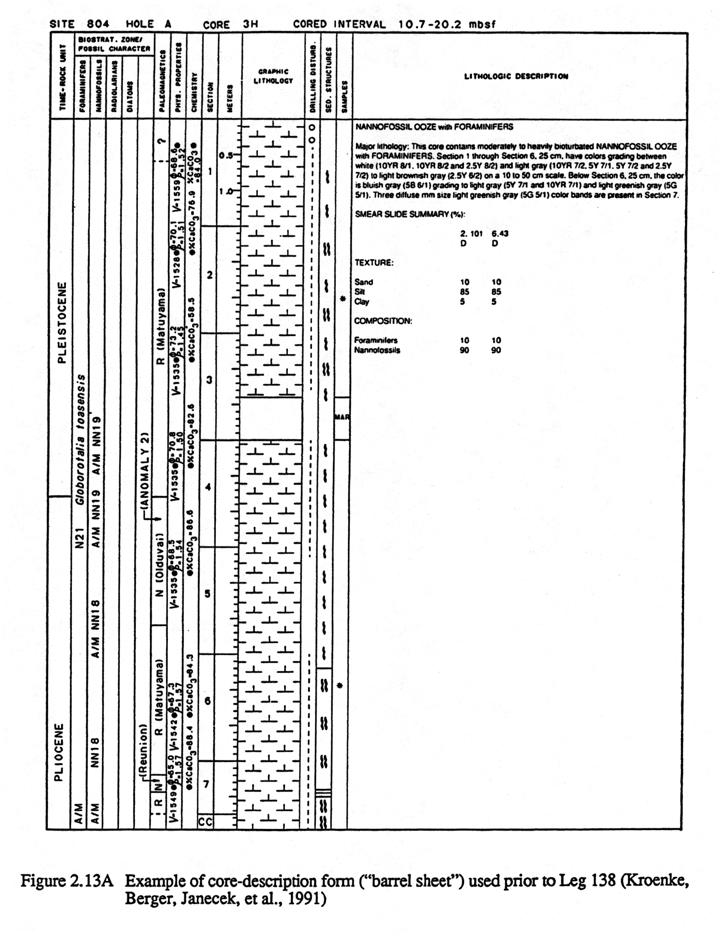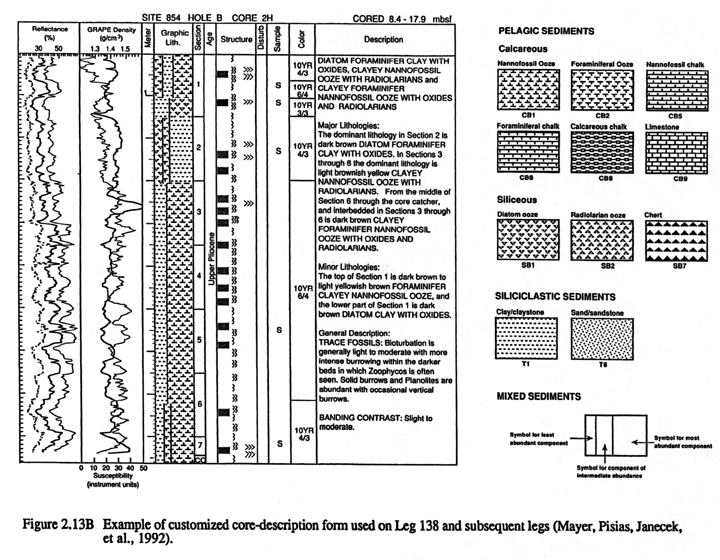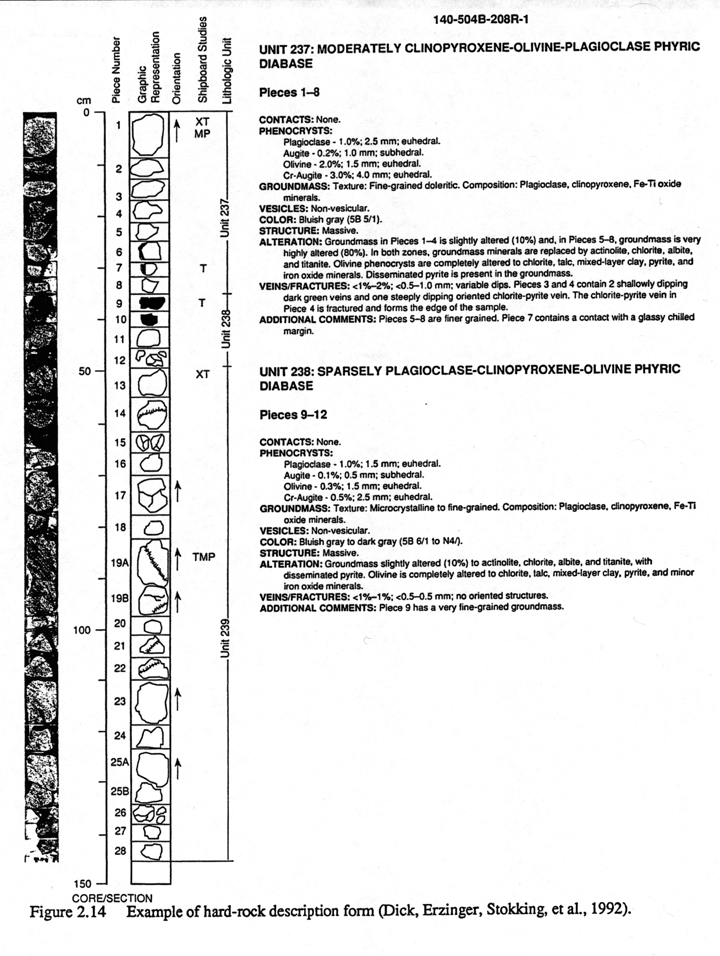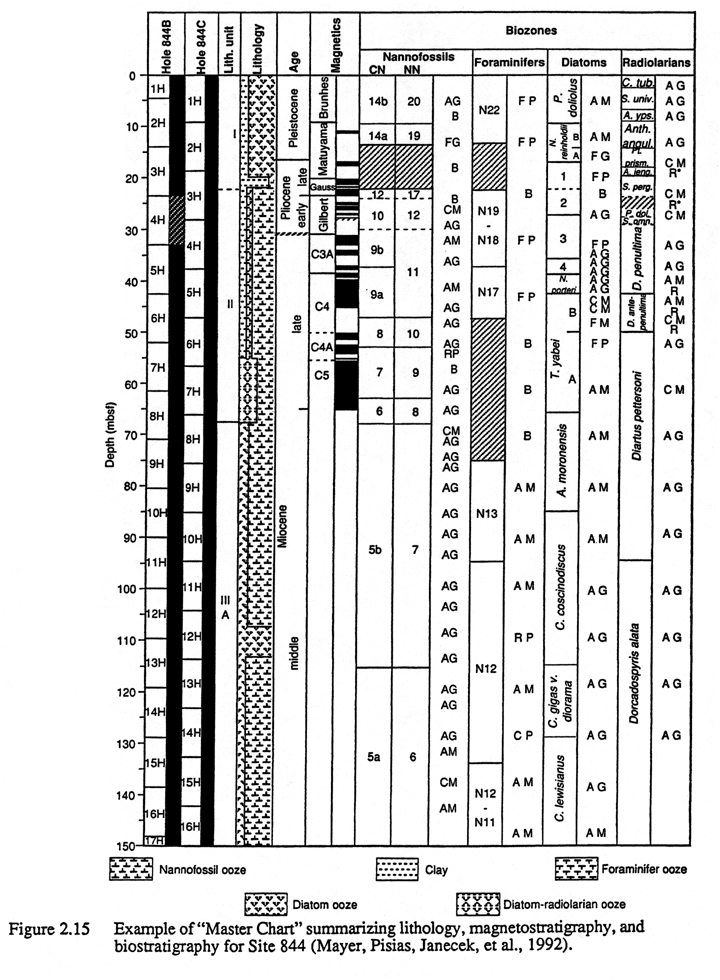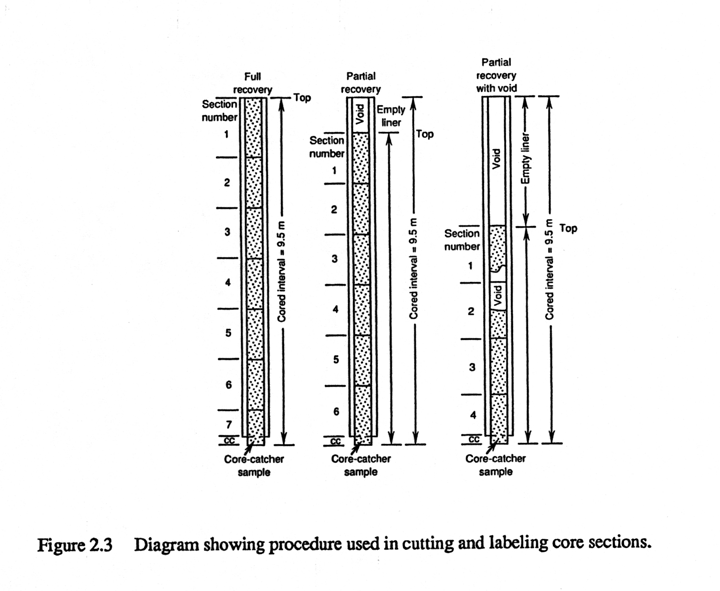
Shipboard scientists collect, analyze, and compile data in accordance with ODP standards and formats. They help the Co-Chief Scientists produce shipboard scientific reports by recording data on standard ODP computerized forms and databases. Shipboard scientists also help to write the site chapters for the Initial Reports of the Proceedings of the Ocean Drilling Program. After the leg, they are responsible for analyzing their samples and reporting the results in manuscripts in the Scientific Results of the Proceedings of the Ocean Drilling Program. All shipboard scientists are encouraged to assist the Co-Chief Scientists in preparing articles for submission to Eos and Geotimes, and a press release for general distribution to news media immediately after the cruise.
Sedimentary Cores
After being cut and brought from beneath the seafloor to the drilling
platform, sedimentary core and its protective core liner are removed from the
core barrel on the rig floor and carried to the catwalk outside the core
laboratory (Fig. 2.1). The ~9.5-m core liner containing the cored material
is set on brackets attached to the catwalk railing. The liner's exterior is
wiped clean, marked, and cut into 1.5-m sections starting from the top of the
recovered material (Figs. 2.2 and 2.3). The last section may be shorter than
1.5 m, depending on the total length of recovered material. Each core
section is capped with a blue endcap at the top and a clear endcap at the
bottom, using acetone to seal the caps to the liner. Material in the core
catcher at the base of the core barrel is put in a short section of core
liner, capped, and placed below the last core section. The sections are
carried into the core laboratory (Fig. 2.4) to be labeled prior to analysis.
A small amount of core-catcher material is removed immediately and taken to
the paleontology lab for age determination. Core-catcher material is often
disturbed during its extrusion from the core catcher (see Chapter 6 for
further discussion); therefore, measurement of magnetic susceptibility using
the multisensor track and measurement of magnetic remanence of this material
are not recommended.

Whole-round samples are removed from some sedimentary core sections for
interstitial-water and physical-properties studies according to a routine
sampling program established by the JOIDES Information Handling Panel (IHP),
and also as part of specific sample requests. The shipboard
biostratigraphers or Co-Chief Scientists may decide to relocate routine
whole-round samples to different intervals, based on preliminary
identification of potentially important stratigraphic information at the
routine location. If shipboard study shows that an important interval or
boundary has been recovered within a whole-round section, the entire
whole-round sample must be returned to the Curatorial Representative for
normal core processing (or special processing as a critical interval, e.g., a
Matuyama/Brunhes transition). Consequently, wherever it is anticipated that
such important intervals may occur, whole-round samples from the core must be
maintained intact until after the age of the core-catcher sample has been
determined. Yellow endcaps are used to indicate where a whole-round sample
has been removed (usually at the bottom of a section); otherwise, clear
endcaps are used at the bottoms of sections.
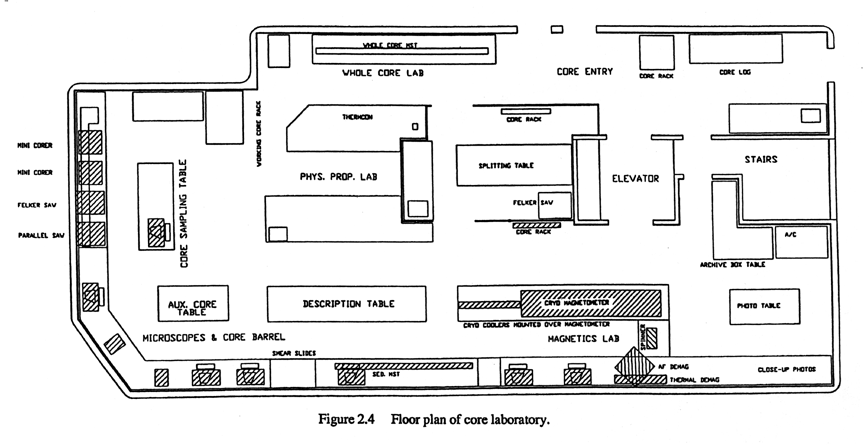
After they are labeled, sedimentary core sections are placed on a storage rack in the core lab. Each section is labeled permanently with its identification code: leg number, site number, hole letter, core number and type (H = advanced hydraulic piston core, X = extended core barrel, R = rotary core barrel, etc.), and section number. For example, the second section of the 10th (rotary-cored) core from Hole 833A, drilled on Leg 134, is labeled "134-833A-10R-2"; the core-catcher section from that core is labeled "134-833A-10R-CC."
After a sedimentary core is permanently labeled and its data entered into the computer database ("CORELOG") by Marine Specialists, it can be accessed for study. The first studies are conducted by shipboard scientists who require whole-round core sections, rather than split core sections, for their analyses. The first analyses conducted on core sections usually include physical-properties measurements (e.g., bulk density [GRAPE], sonic velocity, and thermal-conductivity) and paleomagnetic measurements (e.g., magnetic susceptibility), and may include other measurements that may be required to fulfill the scientific objectives of the leg. In the case of thermal-conductivity measurements, core sections must equilibrate to room temperature before measurements are taken, causing a delay in processing of about 4 hours.
After the completion of whole-core analyses, sedimentary core sections are carried into the core-splitting room, where they are halved lengthwise with rotary saws or wire "cheese-cutters" by Marine Specialists (Fig. 2.5). One half of the split core (the "working half") is taken to the sampling table, where the Curatorial Representative oversees the collection of samples for shipboard and shore-based scientists. The other half of the split core (the "archive half") is taken to the description table for the shipboard sedimentologists or petrologists to describe, and then to the paleomagnetics laboratory to be measured using the cryogenic magnetometer.
Igneous and Metamorphic Cores
When a hard-rock core first arrives on deck, a Marine Specialist marks the bottom of each rock piece recovered in the core catcher that has a cylindrical drilled surface. Smaller, rounded pieces (rollers) are not marked. The rocks from the core catcher are placed at the bottom of the core liner in their correct stratigraphic orientation and order -- no separate core-catcher section is distinguished for hard-rock cores.
The core liner is brought to the catwalk, and the liner's upper end is lifted to shunt loose pieces to the lower end. The liner is then marked and cut into sections; these are ideally 1.5 m long, but section divisions are made on the basis of natural breaks whenever possible to preserve as many long intervals of core as possible. When the sections are brought into the core lab, the total actual length of rock in each (the true core length) is noted. Pieces of rock are carefully shaken out of the liner section before it is split, and the original orientation and order of each piece are maintained. With the assistance of a shipboard structural geologist or petrologist, each piece whose length is greater than the width of the liner (i.e., that could not have rotated around a horizontal axis within the liner) is marked with an arrow pointing up so that the piece's vertical orientation will be preserved.
Pieces in each section are numbered from the top down, starting with 1 (Fig. 2.6). Pieces that fit together along fractures (as determined by a shipboard structural geologist or petrologist) are assigned the same number with upper-case letter suffixes (1A, 1B, 1C, etc.). Spacers are placed between all pieces or groups of pieces, resulting in an archive core length that is greater than the true core length.
When the cores are ready to be split, the structural geologist or petrologist will indicate the plane along which the pieces will be split. Features are split symmetrically between the archive and working halves using a Felker saw. After the pieces are split and dried, they are labeled with piece number and orientation arrow. Labels are attached using epoxy resin such that the orientation arrow on the label points upcore. Until the epoxy gluing the labels to the pieces has dried completely, no one but the shipboard scientist assigned to core reconstruction and splitting and the Marine Specialist assigned to cutting and labeling is permitted to handle the rocks! Otherwise, pieces can easily be misplaced in the core liners, and the original stratigraphic order and orientation of the rocks will be lost.
After they have been labeled, archive halves are taken to the description
table and working halves are taken to the sampling table. Paleomagnetists
may measure hard-rock sections in the cryogenic magnetometer, but should
measure only sections that are complete. Measurements of drilling breccia or
fragments will be inaccurate (see Chapter 6 for further discussion).
Paleomagnetists are permitted to take minicore samples for shipboard
analysis.
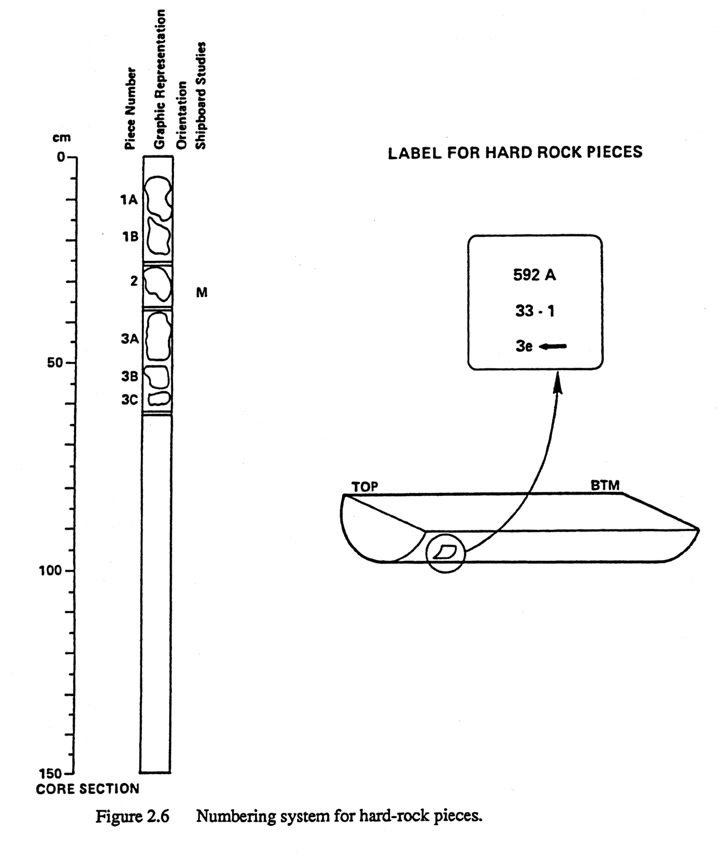
Drilling Progress
Information on drilling progress, including sub-bottom depths, recovery, and age, is displayed both on a white board in the core-entry lab and on television monitors throughout the lab stack. The ODP Operations Superintendent and SEDCO Coring Technician provide drilling information. Paleontologists are responsible for updating sediment-age information upon examination of core-catcher samples, keeping both the white board and the video display current.
Sample Requests
Paleomagnetists begin their participation in the shipboard sampling program by submitting a Cruise Sample Request form (Appendix 1) 2 months pre-cruise. Although shipboard personal sampling is intended to provide material for shore-based studies destined to be published in the cruise Scientific Results volume, one of the primary goals of core curation is to conserve core material. Careful planning and sample selection will help meet both objectives. In order to reduce the amount of sample material removed from cores during the cruise, thus preserving the maximum amount, paleomagnetists are encouraged to view their shipboard personal sampling program as a pilot study. Once specific intervals of interest (e.g., the Miocene) are identified by the shipboard party, a Post-Cruise Sample Request form (Appendix 2) can be completed and given to the Curatorial Representative near the end of the cruise. Upon Co-Chief approval, required for all requests during the first year post-cruise, this request will be processed quickly and the samples shipped shortly after the cores are received at the repository. Additional information regarding sample requests appears in the "Sample Distribution Policy" booklet available from the ODP Supervisor of Curation and Repositories. Questions may be directed to the Supervisor (telephone number 1-409-845-8490, fax 1-409-845-4857) or to the cruise Staff Scientist.
By 1 month pre-cruise, all requests will have been reviewed by the Co-Chief Scientists, the Curator, and the Staff Scientist to identify those which exceed sampling limits or conflict with other requests. Requestors may be contacted at this time in an attempt to resolve any problem before the cruise. Remaining conflicts or problems are resolved on board the ship, during port call or the first transit. Within 24 hours after the ship's departure from port the final cruise sampling plan is transmitted to ODP Headquarters for the Curator's approval.
Subsequent changes to the Sampling Plan are possible, particularly in the event of unexpected findings. However, in such cases the Curatorial Representative must have Co-Chief and/or Staff Scientist approval (and possibly approval from the ODP Curator), and may require that a new Cruise Sample Request form be completed.
Some scientists obtain their samples from preassigned intervals. Others may wish to select sample locations after inspecting the cores, marking the chosen intervals with small labeled flags available at the sampling table. During the transit to the first site, the Curatorial Representative compiles a list of three-letter sample codes that identify each investigator. This list is posted on the white board at the sampling table.
The sampling of critical intervals (important stratigraphic boundaries
such as the Matuyama/Brunhes transition interval; also any interval with
unusually high demand) may be deferred by the Curatorial Representative until
the Curator has approved a sampling plan that maximizes scientific return
from the interval. While shipboard scientists have priority in obtaining
samples of critical intervals, the Co-Chief Scientists may invite shore-based
investigators to participate in cooperative studies of the materials.
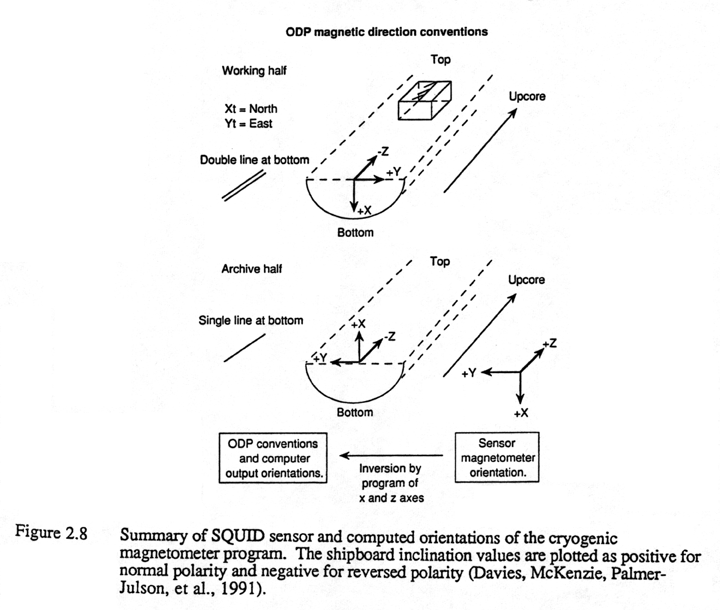
The paleomagnetists, along with all other shipboard scientists, assist in the sampling program (Fig. 2.7). At the beginning of the cruise, the Co-Chief Scientists and Staff Scientist design a sampling schedule so that sampling duties are divided equitably among the entire scientific complement. Sampling duties include routine shifts at the core lab sampling table taking samples for shipboard scientists and shore-based investigators as outlined by the Cruise Sampling Plan. Sampling is directed by the Curatorial Representative.
Paleomagnetic Samples
Shipboard paleomagnetists normally deal with two categories of discrete samples during the cruise: shipboard samples (analyzed on board) and personal samples, which are taken according to individual scientists' approved sample requests and are subject to ODP sampling limits and guidelines. All sampling schemes must be authorized by the ODP Curator prior to the cruise.
Sampling Procedures
Routine ODP sampling procedures have been established with the goal of minimizing sample contamination. The Curatorial Representative will instruct shipboard scientists in these procedures at the outset of the cruise. It is the responsibility of every participant involved in shipboard sampling to ensure that a conscientious effort is made to prevent contamination (further discussion in Chapter 6). Figure 2.8 illustrates the magnetic-direction conventions followed at ODP. Several paleomagnetic samples may be required from each core to resolve the magnetostratigraphy. To orient and remove the samples properly requires care and time. Shipboard paleomagnetists (rather than the paleomagnetic Marine Specialist) are responsible for taking all paleomagnetic samples, or for training other shipboard scientists in the proper techniques. Several sampling methods have been used, the success of which depends on the induration of the sediment. Shipboard supplies for sediment sampling are limited to clear plastic boxes with outside dimensions of 1 in. x 1 in. x 3/4 in. and an interior volume of 7 cm3. Various devices are available for assisting in sampling these cubes. Other sampling containers (such as U-channels or cubes of a different size) must be provided by the scientist who wishes to use them.
Hard-rock samples are taken with either the minicoring drill press,
producing a sample approximately 2.5 cm (1 in.) in diameter, or with the rock
saws (including a double-bladed rock saw), to convenient dimensions. The
minicore cylinders may be cut to prescribed length with parallel ends. The
shipboard paleomagnetist is responsible for marking the orientation of the
piece onto the slab using a stainless steel scribe and/or wax pencil prior to
drilling hard-rock minicore.
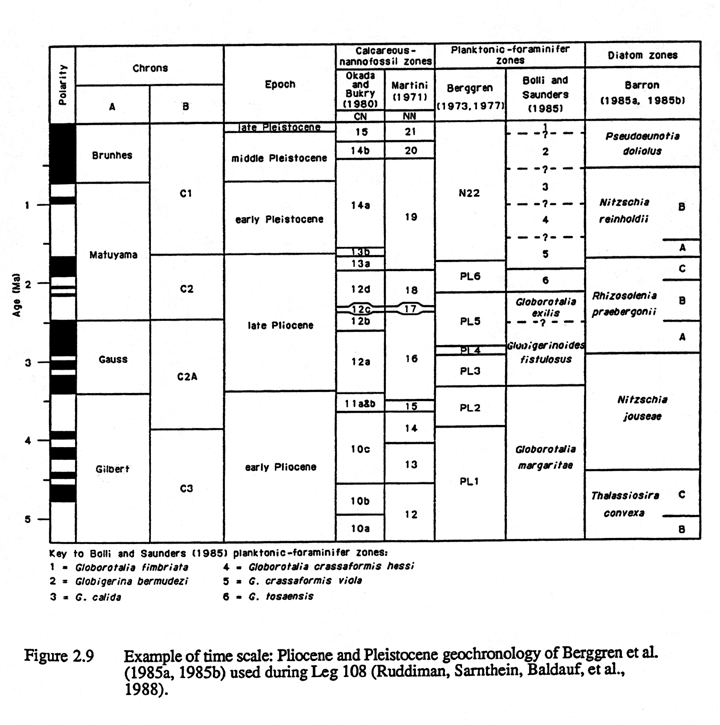
SHIPBOARD PROCEDURES
Most shipboard scientists find that the transit to the first site is the best time to become familiar with the ship and its routines. Classes are held to familiarize scientists with core handling, sampling, core photography, data handling, word-processing, and graphics capabilities of the computer system. Prior to arriving at the first site, the paleomagnetists and the paleomagnetics Marine Specialist should review procedures for each piece of equipment in the lab, check calibrations, and discuss how shipboard paleomagnetic data are processed and plotted. The paleomagnetists compile material for the "Explanatory Notes" chapter of the Initial Reports. Ideally this should be completed before drilling the first site, amended later in the leg to reflect actual practice, and given in final form to the Staff Scientist before the end of the cruise. A general correlation scheme between biostratigraphic zones, the record of magnetic polarity reversals, seafloor magnetic anomalies, and an absolute time scale should be agreed upon by paleomagnetists and biostratigraphers and presented in the Explanatory Notes." Figure 2.9 is an example of the time scale used on Leg 108.
Typically, two paleomagnetists sail on each cruise and work opposite 12-hour shifts. The paleomagnetics Marine Specialist is at present not dedicated full time to the paleomagnetics lab, so that he/she also has responsibilities on the core-receiving deck and in the core lab. The shipboard paleomagnetists conduct or supervise all paleomagnetic measurements and the reduction of paleomagnetic data to intensities and direction of magnetization. Data must be compiled in a manner conformable with ODP standards and format, as explained by the paleomagnetics Marine Specialist at the beginning of the leg. Paleomagnetists are responsible for checking the performance and calibration of the shipboard paleomagnetic laboratory and assuring that it is maintained in good condition. They work with shipboard scientists, Marine Specialists, and the drill crew to ensure that the core material is not damaged (e.g., by heating or exposure to strong magnetic fields), and that core sections are not inverted. Each paleomagnetist is expected to become familiar with shipboard computer facilities and with lab-specific and generic (e.g., word-processing) software used in the paleomagnetics laboratory. Specific duties include overseeing analyses of entire sections using the cryogenic magnetometer and overseeing routine magnetic-susceptibility analyses run on whole advanced hydraulic piston (APC) cores. Magnetic-susceptibility analyses are run in conjunction with other whole-core measurements on the multisensor track, and data are collected directly by computer. Susceptibility data reduction and interpretation are also the responsibilities of the paleomagnetists (or another shipboard scientist designated by the Co-Chief Scientists).
PARTIAL DEMAGNETIZATION OF ARCHIVE SECTIONS
The pass-through cryogenic magnetometer provides the high-resolution records required in studies of magnetostratigraphy and magnetic-field behavior. An alternating-field (AF) demagnetizer in-line with the cryogenic magnetometer can demagnetize cores up to 20 mT, which, in many cases, is sufficient to remove secondary magnetizations. In September 1992 the Information Handling Panel (IHP) recommended that shipboard paleomagnetists be allowed to partially demagnetize the archive half-section of any core to as high a level as is necessary to isolate the characteristic remanence. The maximum demagnetization step size is limited to 15 mT to prevent the destruction of core magnetization without a record of intermediate data. Shipboard paleomagnetists are requested to demagnetize cores at fields no higher than the minimum demagnetization field required to isolate the characteristic remanence. Shipboard paleomagnetists are encouraged to take discrete shipboard samples that can then be demagnetized either thermally or at alternating fields up to 100 mT. These results can then be compared to the results of demagnetization of archive halves to determine whether or not secondary magnetizations were adequately removed.
Figure 2.10 is an example of the magnetostratigraphic results interpreted
from inclination variations on Leg 108. Figure 2.11 illustrates a
magnetostratigraphic synthesis constructed on Leg 138 on the basis of the
data tabulated in Table 2.1. Age information determined both
biostratigraphically and magnetostratigraphically is used to produce
sediment-accumulation-rate diagrams (Fig. 2.12; Table 2.2). (See the
Explanatory Notes" chapter of the Leg 138 Initial Reports for a thorough
discussion of sedimentation rates, sediment-accumulation rates, and the
errors involved.)
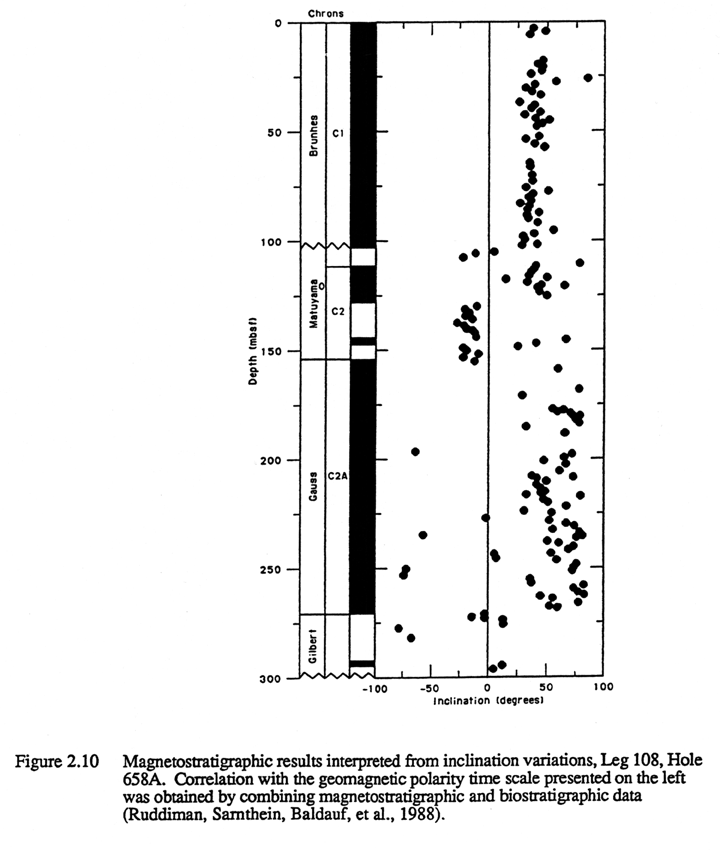
CORE ORIENTATION
Oriented cores provide potentially the best paleomagnetic information.
The Eastman-Whipstock multishot tool and the Tensor tool (discussed further
in Chapter 3) can orient cores to within a few degrees, enabling
paleomagnetists to determine the magnetostratigraphy of sediment even from
equatorial regions (as demonstrated during ODP Leg 108) and to study both
geomagnetic-field behavior and plate motions.
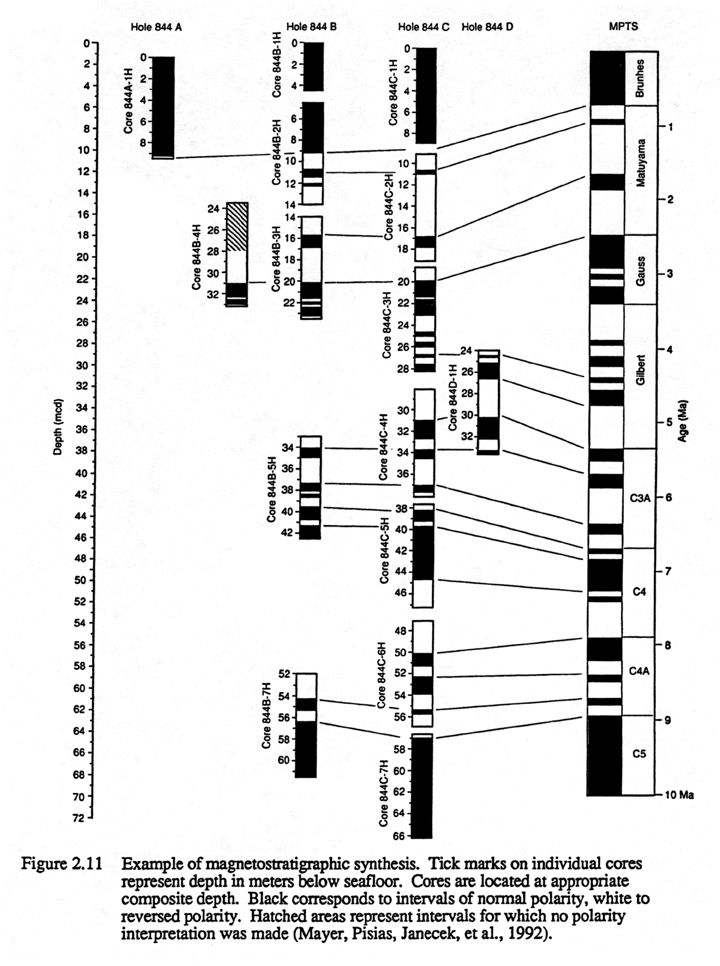
Paleomagnetists should discuss
the need for oriented cores with the Co-Chief Scientists, Staff Scientist,
and Laboratory Officer so that plans to use the nonmagnetic Monel drill
collar and the multishot" or Tensor tool can be finalized well in advance of
drilling. ODP is currently developing several new core-orientation
techniques, including digital systems, the use of logging tools such as the
formation microscanner and borehole televiewer to assist in core orientation,
and hard-rock orientation systems.
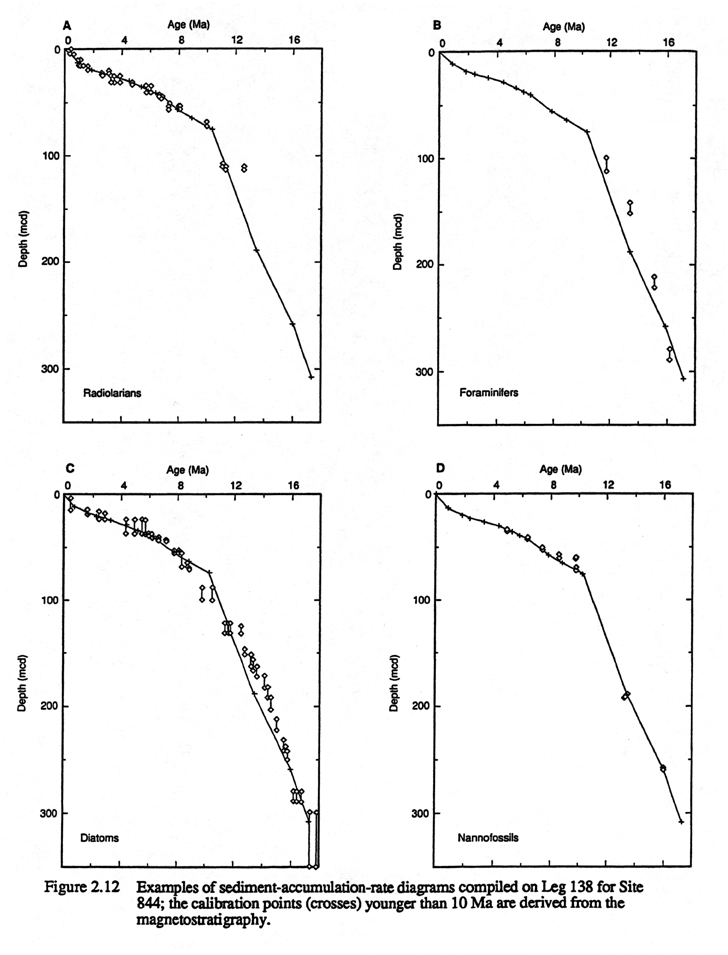
ROCK MAGNETIC STUDIES
Rock magnetic studies provide information about the carriers and fidelity of magnetic remanence. The following rock magnetic equipment is available in the shipboard paleomagnetics laboratory:
1. DTECH Partial Anhysteretic Remanence Magnetizer: This double-coil system used in conjunction with the Schonstedt AF demagnetizer is designed to produce an ARM acquired in a DC field up to 1 mT (10 gauss) and alternating fields up to 100 mT (limit of AF demagnetizer). ARM acquisition can be studied by applying increasing AF fields to the sample and measuring the sample (either in the spinner or cryogenic magnetometer) between steps. The system can produce a partial ARM (PARM) by exposing the sample to the demagnetizing field only when the field is in the range specified by the user. A sample holder constructed on board ship during Leg 140 permits the study of anisotropy of ARM.
2. ASC Impulse Magnetizer: The impulse magnetizer is designed to study the acquisition of isothermal remanent magnetizations (IRM) in a sample. A sample holder provided by the manufacturer permits the study of anisotropy of IRM.
3. Kappabridge KLY-2 Magnetic Susceptibility/Anisotropy System: This instrument measures the magnetic susceptibility and anisotropy of magnetic susceptibility over a wide sensitivity range.
HOLE SUMMARIES
When drilling at a site has been completed, the shipboard scientists compile a site report consisting of a series of short chapters by each working group and the "barrel sheets" for all cores from the site. Collectively the reports from the entire leg are known as the cruise Hole Summaries; copies are distributed by ODP shortly after the cruise to all shipboard and shore-based investigators. After revision by the shipboard party during the post-cruise meeting, the Hole Summaries are published as the Initial Reports volume of the Proceedings of the Ocean Drilling Program. Additional material such as the Explanatory Notes" chapter, underway geophysics reports, and site survey papers may also be published in this volume.
As noted previously, details regarding methods used to generate data and analyze results should NOT be included in each chapter. Instead, a brief explanatory discussion of equipment and techniques used should be included in the "Explanatory Notes" chapter (see recent Initial Reports volumes for examples).
All shipboard scientists must use correct, complete designations for cores, sections, and samples when writing parts of the Hole Summaries:
Site Designation: Refers to the location of all holes drilled at one
beacon position.
Example: Site 828
Hole Designation: Refers to the holes actually drilled.
Example: Hole 828A
Core Designation: Leg-(site+hole letter)-(core number+core type).
Example: 134-828A-10H
Section Designation: Leg-(site+hole letter)-(core number+core
type)-section number
Examples: 134-828A-10H-1; 134-828A-10H-CC (for core-catcher)
Sample Designation: Leg-(site+hole letter)-(core number+core
type)-section number, (sample interval in centimeters)
Example: 134-828A-10H-1, 116-118 cm
The paleomagnetists' contribution to the Hole Summaries are the "Paleomagnetism" and "Sedimentation Rates" chapters. The "Paleomagnetism" chapter summarizes magnetostratigraphy, paleomagnetic direction and pole analysis, rock and mineral magnetism, magnetic susceptibility, and any other relevant paleomagnetic/rock magnetic information. Often, responsibility for writing the "Paleomagnetism" chapter of the Initial Reports alternates between the two shipboard paleomagnetists. The "Sedimentation Rates" chapter is a collaborative effort with the biostratigraphers and is a short summary of datums and interpretation of the accumulation rate(s) of the sedimentary section at the site.
Writers of the "Paleomagnetism" and "Sedimentation Rates" chapters are advised to report all datums, ranges, zonal boundaries, etc., in terms of meters below seafloor (mbsf) rather than lithologic units (as defined by the sedimentologists). Later revision of lithologic units often causes confusion and error that may persist through publication of the cruise volume. Correlation among units defined by various shipboard groups is better presented in an easily updated diagram in a summary section of each site chapter, or in a separate summary chapter.
For each site's "Paleomagnetism" chapter, a report is compiled by a designated lead paleomagnetist who writes introductory and discussion material as appropriate. A summary magnetostratigraphic chart (see example in Fig. 2.11) should also be drawn; interaction with the other working groups is important if this age information is to appear correctly in other chapters. Be particularly careful that revisions to age information are made to every occurrence of that information in the Hole Summaries (e.g., to an "age" column in a lithologic diagram).
The "Sedimentation Rates" chapter is typically a collaborative effort between the paleontologists and paleomagnetists, any of whom may be designated lead author. A sedimentation-rate diagram (Fig. 2.12) is compiled on the basis of biostratigraphic and paleomagnetic datums; detailed information regarding these datums should be presented in an accompanying table or tables (Table 2.2). The text presents an interpretation of the diagram and any appropriate additional information.
CORE DESCRIPTIONS
Prior to Leg 138, shipboard paleomagnetists summarized magnetostratigraphic information from sedimentary cores on standardized core-description forms ("barrel sheets"; Figs. 2.13A and B) circulated among the scientific groups on board, and published in the Initial Reports. Since Leg 138, barrel sheets are designed and customized by the shipboard parties of each leg, who select any additional information to be included beyond a basic set of observations on lithology, core disturbance, and sedimentary structures. Magnetostratigraphic or magnetic-susceptibility data are options which may be included if these are thought particularly valuable.
Igneous and metamorphic cores are described by section on hard-rock visual core-description forms (Fig. 2.14). These forms include a column showing the location of samples taken for shipboard analysis, including discrete paleomagnetic samples.
Many shipboard parties summarize information from each hole or site on a
diagram commonly referred to as a Master Chart (Fig. 2.15).
Magnetostratigraphic or magnetic-susceptibility data are often included.
